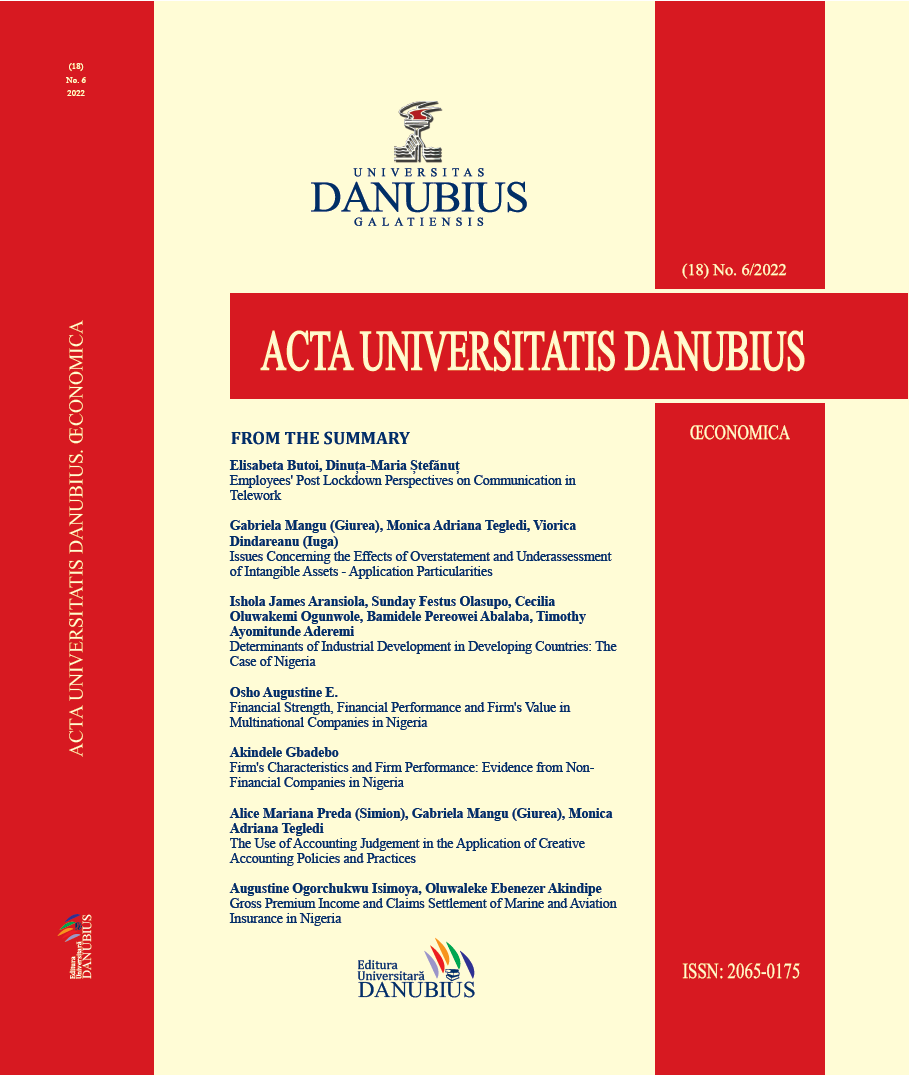Asset Size and Profitability of Life Insurance Companies in Nigeria. A Panel Data Approach
Abstract
The magnitude of a company is a crucial element in evaluating organizational ascendancy while economies of scale are an advantage for most large corporations. This study examined how the size of life insurance companies' asset base affect profitability in Nigeria between 2011 and 2021. Data on assets of life insurance companies and the insurance digest of the Nigerian Insurers Association (NIA) were used to determine profit after tax and asset size for the relevant period. The data's stationarity test revealed that the data are stationary at the significance levels of 1%, 5%, and 10%. Data are statistically significant because the calculated probability (F-statistic) value from the ordinary least squares regression is smaller than the 0.05 significant value. The profit after tax is accounted for by 73.8811 percent of the total assets of life insurance firms, according to the computed linear coefficient of determination (R2= 0.738811). The study's findings report that asset size affects the financial success of insurance businesses in Nigeria.
References
Akbas, D. & Karaduman, J. (2012). Impact of macroeconomic and financial market indicators of the banking sector: Some evidence from India. International Journal of Research in Finance and Marketing, 2(2), 172-185.
Akinyomi, J., & Olagunu, A. (2013). Effect of firm size on profitability: Evidence from Icelandic firms. Bifrost Journal of Social Science, 1, 43–55.
Amaton, F.M. & Burson, O.P. (2017). Effects of employees’ perception on purchase of motor insurance. IOSR Journal of Business and Management, 18 (8), 126-132.as Myth and Ceremony. American Journal of Sociology 83 (2), 340-363.
Bobakova, I. V. (2019). Factors affecting bank profitability. Journal of Banking and Finance, 3(11), 2080-2092.
Chen, L. (2019), effects of firm specific factors and macroeconomics on profitability of property-liability insurance industry in Taiwan, Asian Economic and Financial Review
Chicago: University of Chicago Press.
Ching, H., & Gerab, F. (2020). Determinants of financial performance in Brazilian companies: a multi-ratio model using multivariate statistical method. Journal of Global Business and Economics,5(1), 79-99.
DiMaggio, P., and Powell, W. (2019). The iron Cage revisited: Institutional Isomorphism and Collective rationality in organizational Fields. American Sociological Review, 48(2), 147-160.
European Central Bank (2017). Financial Stability Review. Retrieved from www.ecb.europa.eu.
Hofman, D. M. (2019). Insurance - a global view: Markets, participants and challenges. Zurich Insurance Company Ltd.
Jonsson, B. (2019). Does the size matter? .The relationship between size and profitability
Kaguri, N. (2020). ‘Relationship between firm characteristics and financial performance of life insurance companies in Kenya’, MSC thesis, University of Nairobi
Malik, S. (2019). determinants of insurance companies profitability: Ananlysis of insurance
Mehrjardi, M., (2020). Size and profitability of Banks in Kenya. Unpublished MBA Project, University of Nairobi.
Meyer, J. W., and Rowan, B. (2021). Institutionalized Organizations: Formal Structures
Nguyen, J. (2019). An empirical analysis of Commercial Bank Profitability in Financially Liberalized Markets, University of New Orleans Theses and Dissertations, Paper 1048.
Nigerian Manufacturing Sector, Prime Journal of Business Administration and Management, 3(9), 1171-1175. of Icelandic firms. Bifrost Journal of Social Science, 1, 43–55.
Oyeniyi, O.J., Abiodun, J.A., Obamiro, K.J., Moses, C.L., & Osibanjo, O.A. (2016). Research methodology with simplified step-by-step application of SPSS package. Lagos: Pumark Nigeria Limited.
Peng, B. (2019). The perceptions and experiences of people injured in motor vehicle crashes in a compensation scheme setting: A quantitative study. BMC Public Health, 15 (423), 1-10.
Powell, W., & DiMaggio, P. (1991). The New Institutionalism in organisational analysis.
Rowthwer, D. (2013). Designing ex-post facto and experimental studies. 12 ed. London: Routledge. sector of pakistan. Academic Research International., 1(3): 315-319.
Sharma, E., & Mani, M. (2021). Impact of macroeconomic and financial market indicators of the banking sector: Some evidence from India. International Journal of Research in Finance and Marketing, 2(2), 172-185.
Swiss Re Institue. (2018). World insurance: the great pivot east continues (3). Retrieved from www.swissre.com
Todaro, S. (2020). Customer perception towards general insurance: A factor analysis approach. Journal of Management Research and Analysis, 7 (1), 15-20.
Velnampy, T., & Nimalathasan, B. (2019). Firm size on profitability: A comparative study of Bank of Ceylon and Commercial Bank of Ceylon Ltd in Sri Lanka. Global Journal of Management and Business Research, 10(2), 96–100.
Woodward, J. (2019). Industrial Organizations, Theory, and Practice, London: Oxford University Press.
Downloads
Published
How to Cite
Issue
Section
License
Copyright (c) 2022 Sunday Adekunle Aduloju, Oluwaleke Ebenezer Akindipe

This work is licensed under a Creative Commons Attribution-NonCommercial 4.0 International License.
The author fully assumes the content originality and the holograph signature makes him responsible in case of trial.


